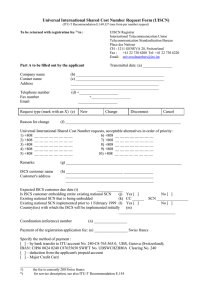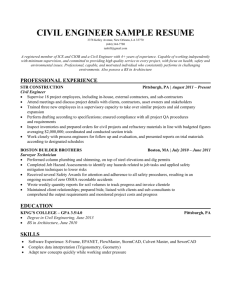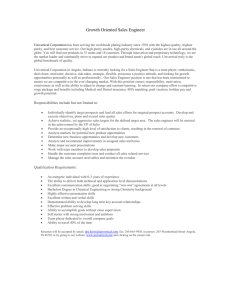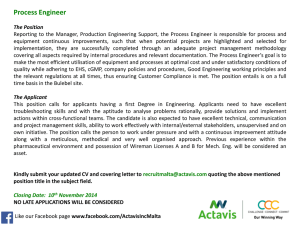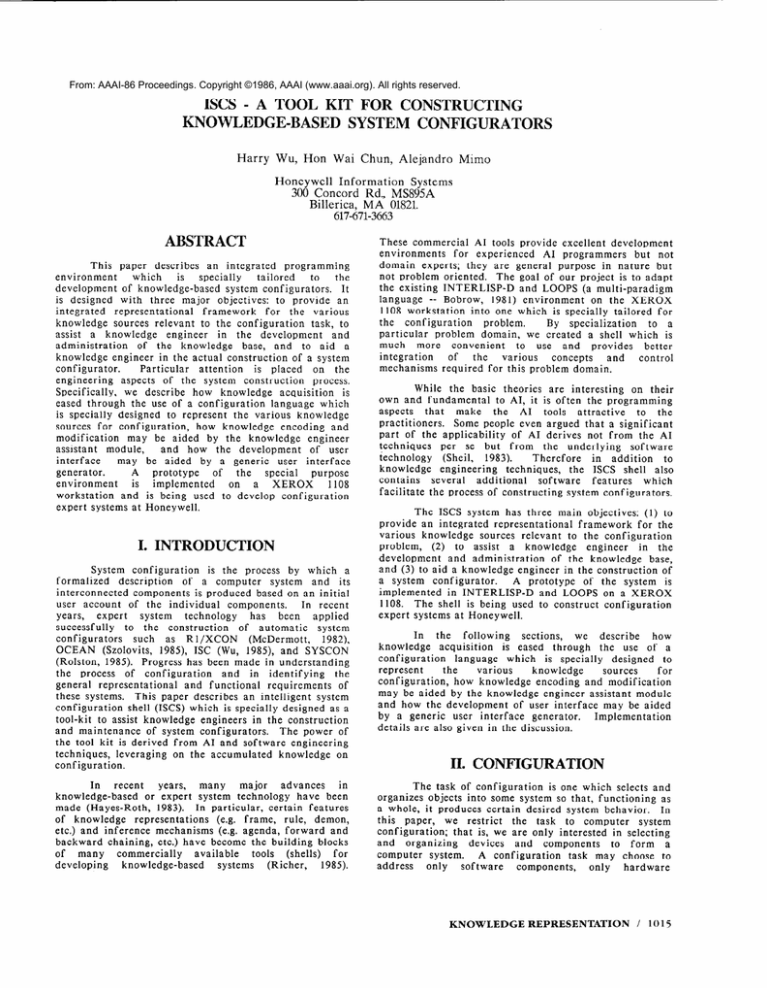
From: AAAI-86 Proceedings. Copyright ©1986, AAAI (www.aaai.org). All rights reserved.
ISCS - A TOOL KIT FOR CONSTRUCTING
KNOWLEDGE-BASED SYSTEM CONFIGURATORS
Harry
Wu, Hon
Wai Chun,
Alejandro
Mimo
Honeywell
Information
Systems
300 Concord Rd., MS895A
Billerica, MA 01821.
617-671-3663
These commercial
AI tools provide excellent development
environments
for experienced
AI programmers
but not
domain experts; they are general purpose in nature but
not problem oriented.
The goal of our project is to adapt
the existing INTERLISP-D
and LOOPS (a multi-paradigm
language -- Bobrow, 1981) environment
on the XEROX
1108 workstation
into one which is specially tailored for
the configuration
problem.
By specialization
to a
particular
problem domain, we created a shell which is
much
more
convenient
to use and provides
better
integration
of
the
various
concepts
and
control
mechanisms
required for this problem domain.
While the basic theories
are interesting
on their
own and fundamental
to AI, it is often the programming
aspects
that
make
the
AI tools
attractive
to the
practitioners.
Some people even argued that a significant
part of the applicability
of AI derives not from the AI
techniques
per se but from
the underlying
software
technology
(Sheil,
1983).
Therefore
in addition
to
knowledge
engineering
techniques,
the ISCS shell also
contains
several
additional
software
features
which
facilitate
the process of constructing
system configurators.
I. INTRODUCTION
System configuration
is the process by which a
formalized
description
of a computer
system
and its
interconnected
components
is produced based on an initial
user account of the individual
components.
In recent
years,
expert
system
technology
has
been
applied
successfully
to the construction
of automatic
system
configurators
such as Rl/XCON
(McDermott,
1982),
OCEAN (Szolovits,
1985), ISC (Wu, 1985), and SYSCON
(Rolston, 1985). Progress has been made in understanding
the process
of configuration
and in identifying
the
general representational
and functional
requirements
of
these systems.
This paper describes an intelligent
system
configuration
shell (ISCS) which is specially designed as a
tool-kit to assist knowledge
engineers
in the construction
and maintenance
of system configurators.
The power of
the tool kit is derived from AI and software engineering
techniques,
leveraging
on the accumulated
knowledge
on
configuration.
years,
many
major
advances
in
In
recent
knowledge-based
or expert system technology
have been
made (Hayes-Roth,
1983). In particular,
certain features
of knowledge
representations
(e.g. frame,
rule, demon,
etc.) and inference
mechanisms
(e.g. agenda, forward
and
backward chaining, etc.) have become the building blocks
commercially
available
tools
(shells)
for
of many
developing
knowledge-based
systems
(Richer,
1985).
The ISCS system has three main objectives:
(1) to
provide an integrated
representational
framework
for the
various knowledge
sources relevant
to the configuration
problem,
(2) to assist
a knowledge
engineer
in the
development
and administration
of the knowledge
base,
and (3) to aid a knowledge engineer in the construction
of
a system configurator.
A prototype
of the system is
implemented
in INTERLISP-D
and LOOPS on a XEROX
1108. The shell is being used to construct
configuration
expert systems at Honeywell.
In the
following
sections,
we describe
how
knowledge
acquisition
is eased through
the use of a
configuration
language
which is specially
designed
to
represent
the
various
knowledge
sources
for
configuration,
how knowledge encoding and modification
may be aided by the knowledge engineer assistant module
and how the development
of user interface
may be aided
by a generic user interface
generator.
Implementation
details are also given in the discussion.
II. CONFIGURATION
The task of configuration
is one which selects and
organizes objects into some system so that, functioning
as
a whole, it produces certain desired system behavior.
In
this paper,
we restrict
the task to computer
system
configuration;
that is, we are only interested
in selecting
and organizing
devices
and components
to form
a
computer
system.
A configuration
task may choose to
address
only
software
components,
only
hardware
KNOWLEDGE
REPRESENTATION
/
10 15
or both; we describe
them as software
components,
hardware
configuration,
and integrated
configuration,
system configuration
respectively.
Configuration
activities
are traditionally
carried
out by different
organizations
within
a computer
company
for different
purposes.
For instance,
sales
computer
systems to fit the
representatives
“configure”
needs of customers
while
field
engineers
“configure”
computer systems to fit physical installation
requirements.
Rl
(McDermott,
1982) was developed
before
XSEL
(McDermott,
1982) and thus are sometimes
viewed
as
In
reality,
the
two
activities
separate
systems.
complement
each other.
The difficulty
of one activity
may be reduced
if knowledge
relevant
in the other
activity
can
be made
available;
usually
the
sales
representatives
and field engineers maintain contact with
each other in order to consummate
an order.
The design
of ISCS is such that it may be used to construct
a sales
configurator,
an engineer configurator,
or one which
encompasses both activities.
In order to come up with a shell for the system
configuration
problem domain, one must first identify
the
tasks and knowledge
common
to system configuration
problems in general and then decide how they might be
represented
conveniently.
This problem is first studied by
McDermott in his seminal paper (McDermott,
1982) where
he demonstrated
that this can be solved by a rule-based
system using only forward
chaining.
In a later system,
OCEAN (Szolovits,
1985), the developers
used a richer
environment
involving
hybrid
representations.
Our
approach
is similar
to that
of OCEAN.
While a
knowledge-based
configurator
system can be implemented
by forward
rules alone, we feel that by using a richer
environment
and representation,
knowledge
encoding
is
made conceptually
closer to actual expert knowledge
and
hence easier to construct.
In particular,
maintenance
of a
knowledge
base is made simpler
by having
modular
sources of configuration
knowledge.
One may
view
the configuration
process
as
consisting
of a data entry and value validation
phase, a
completion
phase, and an assignment
phase.
The process
usually starts with the specification
of the components
to
be included
in the target
system
and
site-specific
information.
A configuration
expert sorts through
the
mass of data to validate
the values and to see if the
information
is complete.
If components
are missing, they
are added to the system.
Finally, the expert attempts to
build a viable configuration
which satisfies
the sitespecific requirements.
The output from the configuration
is a highly detailed and formalized
document
recording
the spatial, or functional
layout of the components.
The
configuration
task is usually tedious and error-prone
due
to the large amount of information
involved.
Moreover,
information
the
changes
with
time
because
old
components
and systems become obsolete while new ones
are introduced.
The task is also complicated
by the fact
that
the initial
specification
is seldom
accurate
or
complete
many iterations
of the configuration
process
actually take place between the time a sales proposal is
first initiated till the system is delivered and installed.
Several sources of knowledge
are required
in the
system
configuration
process:
knowledge
about
the
individual
components,
knowledge
about
the
interrelationships
among components
and between components
and
systems,
knowledge
about
the
configuration
procedures,
and knowledge about the format of the output
1016
/ ENGINEERING
description.
In ISCS, separate knowledge
representations
are used to capture these knowledge
sources.
Although
some of these ideas have been studied
and advocated
elsewhere (Hayes-Roth,
1983), our goal is to illustrate how
they may be packaged
and utilized
in the domain
of
system configuration.
In this section, we provide a brief
conceptual
overview
of three of the more interesting
knowledge
sources - the component model, the constraint
demons, and the configuration knowledge.
Details on each
knowledge source are provided in the next section.
Information
about components
and system types
are described
by the component
model which defines the
attributes
and options
of the components
and systems.
The component
model constitutes
a taxonomic hierarchy
of class and sub-classes and a part-of hierarchy
to depict
the relationship
between parts and sub-parts.
Properties
may be inherited
along the descendant
path within
a
hierarchy.
Constraints
and dependencies
may arise
when
different
types of components
are assembled together into
a system.
Constraint
demons are provided to capture this
type of dependency
knowledge.
Constraint
demons have
two basic constituents:
descriptive
predicates
and sets of
imperative
actions.
The predicates
define the constraints
and the context
under
which
the demons
should
be
triggered, while the actions indicate the activities
(usually
remedial corrections)
to follow.
The
configuration
knowledge
consists
of
a
hierarchy
of
involved
in
procedural
knowledge
configuration.
At the bottom level are operations where
each operation
acts on a set of objects
of the same
component
type.
For example,
an operation
may be
selecting an object from a set, or modifying
every object
in a set. At the next level are tasks which are composed
of sequences of operations
(hence tasks may act on objects
of different
component
types).
For instance, a task may
act first on an aggregate
and then its sub-parts
by a
sequence of operations
along a “part-of” path. Above the
tasks are plans which decide which tasks to execute.
III. ISCS
Although
there are a large variety of tools and
knowledge
representations
embedded
in ISCS, integration
and coherence
are achieved
by relying
on a objectoriented
programming
paradigm.
A similar strategy has
been adopted in another tool-kit (Lafue, 1985). Figure 1
provides a schematic diagram of ISCS. In the middle of
the figure are the modules of the shell consisting
of a
knowledge
engineer
assistant
module,
a control
and
inference
module, an user interface
generator,
and a site
database
manager.
The knowledge
engineer
assistant,
KEA, provides
“structure-based”
editors for the various
types of knowledge representations.
It is the main vehicle
for knowledge
entry and maintenance.
The KEA also
interprets
knowledge
structures
created through the ISCS
configuration
language into the internal
representations.
The control and inference
module, CT, decides
how a
configuration
session proceeds by looking up site-specific
data from the data base and system-specific
configuration
knowledge
from the knowledge
base. The user interface
generator,
WSI, is a tool that allows a knowledge engineer
to create
and customize
an end-user
interface.
The
database
manager
handles
the storage and retrieval
of
site-specific
data.
contain-parts
relation is always a list to indicate an oneValues may be inherited
along the
to-many relationship.
part-of hierarchy
as well. In the example of figure 2, the
channel number of a 7301 terminal is obtained
from the
synchronous
communication
line it is attached to. Unlike
the taxonomic
case where inheritance
is at the class level,
the part-of inheritance
is at the instance level; values are
automatically
copied when two objects are linked together
e.g. (AddTo <an instance
of
by an “AddTo” operation;
SynchronousCommunicationLine>
‘TerminalAttached
<an
instance of T7303>).
A. ISCS knowledge sources
This subsection
presents
the major
knowledge
sources in ISCS. These knowledge
sources correspond
to
of knowledge
required
in the
‘the various
types
configuration
task.
1. The Component Model
The component
model captures information
about
individual
systems and components.
Each type of system
or component
is defined by a class, i.e. “prototype record”,
which contains
variables, i.e. “attributes”,
related to that
object type. Instances, i.e. “objects”, of the same class will
kinds
of
Two
identical
record
structure.
have
relationships
may be specified between classes.
(CLASS
Terminal
.. .
(CLASS
(BaudRate
SynchronousTerminal
. ..
The taxonomic
hierarchv:
In ISCS, this classsubclass
hierarchy
permits
the knowledge
engineer
to
define paths for class inheritance.
For example, in figure
2, the “7301” class is a subclass of “synchronous
terminal”
All
class which in turn is a subclass of “terminal” class.
such as standard
1200 baud rate, about a
properties,
terminal will also be inherited
by a 7301 terminal unless
indicated otherwise.
(CLASS
. .. 1
1200)
(Super
Terminal)
... )
T7301
(Super
SynchronousTerminal)
(TerminalAttached-INV
NIL
Part-Of
(SynchronousCommunicationLine))
(ChannelNumber
(Inherit
(CLASS
The part-of hierarchv:
Variables
of a class may
possess the “contain-parts”
property which is a list of class
subnames. Instances of classes in the list are considered
For instance,
the example in figure 2 illustrates
parts.
that terminals of type 7301, 7303, or 7305 may be hung on
The “part-of” and
a synchronous
communication
line.
“contain-parts”
are inverse relationships;
as soon as one
the
other
direction
will
be
direction
is defined,
The variable
name in the other
automatically
added.
direction
is given by adding
a suffix
“-INV” to the
The value for either
the part-of
or
variable
name.
TerminalAttached-INV))
SynchronousCommunicationLine
...
(TerminalAttached
NIL
Contain-Parts
(ChannelNumber
Figure
.. . )
2. Example
NIL)
(T7301
T7305
T7307))
. .. )
of taxonomic
and part-of
hierarchy.
2. The Constraint Demons
Constraint
demons
are the means by which
a
knowledge
engineer may specify restricted
conditions
and
remedial
corrections
if these conditions
are violated.
A
constraint
demon has three properties:
scope, predicate,
User
User Interface
r-7
E7
/
v
Conflguration
Output
Knowledge
Engineer
Site Data
nowledge
Figure
1. Schematic
diagram
Base
of ISCS and its environment.
KNOWLEDGE
REPRESENTATION
/
10 17
and action.
Currently
ISCS support two types of demons
which are “triggered” under different
circumstances.
For
a value demon, the corresponding
predicate is tested at the
time when a value is being stored
into an instance
For
a class demon
the
variable
of an object.
corresponding
predicate
is tested
every
time a new
If the
instance
from the (immediate)
class is created.
predicate evaluates to false then the actions are executed.
The scope property of a demon indicates
whether it is a
value or class demon.
The action property contains a list
of actions that may be performed
if the predicate
is not
The
conditional
portion
of the
action
satisfied.
to select
specification
allows
a knowledge
engineer
When a demons’s
appropriate
actions
by context.
predicate
is found to be false, each action is then carried
out sequentially.
The variable “Predicate” is bound to the
result of the evaluation
of the demon’s predicate
and is
made available to all the actions.
Constraint
propagation
may be explicitly turn on or off for each demon action.
The first demon in figure 3 validates
baud rates.
The demon will check values that are to be stored into
either a 7307 or 7309 terminal.
The legitimate
values are
There are two actions
in the
1200, 4800, and 9600.
One of them will be executed
during
input
example.
when
a user
enters
data
into
the
system
phase
the other
will be executed
during
the
interactively,
completion
phase when the system automatically
complete
all necessary information.
The second demon makes sure
that there are enough synchronous
communication
lines
for 7307 terminals given the fact that at most five 7307’s
can be hung from one line. If not enough lines are there,
In this case, constraint
then a new one is added.
propagation
is turned on because there might be other
monitoring
synchronous
demons
the
creation
of
communication
lines.
(DEMON
evaluated
before
an object
is operated
on.
If the
predicate
fails then that particular
object is skipped.
The
number of objects that are to be tested and worked on
depends on the “Repeat” attribute
(see figure 4). There
are two automatically
generated
variables associated
with
each operation.
After the execution
of an operation,
these two variables
will contain respectively
the objects
that have been worked on or not.
Figure 4 shows an
operation
which iterates through all 7307 terminals
and
assign each one to a communication
line. In the example
the variable “self” is bound to a different
object during
each iteration. After the operation, the variables,
“T7307.AssignTerminalToCommLine.Done”
“T7307.AssignTerminalToCommLine.NotDone”,
and
will contain respectively
the terminals that have been
attached and those that are still loose.
(OPERATION
AssignTerminalToCommLine
(’ attach each 7307 terminal to a comm line)
(Class
T7307)
(Predicate
T)
(Repeat UntilExhausted)
(Code (AddTo(GetAnInstance
SynchronousCommunicationLine)
‘TerminalAtt
ached self))))
(HIERARCHICAL-TASK
Documentation
(* Output each comm line and its terminals)
(Root
(Paths
SynchronousCommunicationLine)
(SynchronousCommunicationLine
TerminalAttached))
(Code
((Class
SynchronousCommunicationLine)
(IF <predicate>
THEN (Document))
((Class
T7307)
(IF T THEN
(ITERATIVE-TASK
PutCardsOnBoards
(* assign all cards
(Type ALLI
(Predicate
(AND
(Epilog
CheckBaudRate
to boards)
(NULL Type-1-Card.NotDone)
(NULL Type-2-Card.NOtDone)))
(IF (OR Type-1-Card.NotDone
Type-2-Card.NOtDone)
(* 7307 & 7309 baud rates)
(Scope
(Predicate
Value
BaudRate)
(T7309
BaudRate))
(1200
(Actions
THEN
(T7307
(MEMBER
(Variables
4800
(Rl:(SETQ
9600)))
THEN
(<-a
BaudRate
(PROMPTPRINT
NIL)
<message>))
(IF CompletionPhase
THEN
(<-a
BaudRate
1200))
(DEMON
LineForTerminalExists?
(* max. of five 7307 terminals
(Scope
(Predicate
Class
(LESS
(Actions
))
NewBoard(Operation
T7307)
(PROMPTPRINT
NewBoard))
(RS:(Operation
Type-a-Card
AllocateSlot
NewBoard))))
(Repeat 1)
(Code (Return
3. Example
of constraint
3. The configuration
<message>))
(Predicate
(Code
to a board
(Type-l-Card-Fit?
(Fix-Slot
(PLAN
as possible)
NewBoard))
NewBoard)
self NewBoard)))
Card-type-l-Or-Card-type-2
(Rules
demons
(MyRule:
r2 and r3 in task PutCardsOnBoards)
(If <predicate>
(XChange
THEN
PutCardsOnBoards
R2: R3:)))))
procedural knowledge
Operation:
An
operation
applies
the
same
procedure to all the objects of the same class; e.g. send the
same message to every objects of the same class.
In
addition,
there is a preconditional
predicate
which is
/ ENGINEERING
list)
self)))
(Decrement-slot
‘On)
ISCS provides a mean to decompose the procedural
aspects
of configuration
into more manageable
units.
These units are organized in a hierarchy
of three layers:
1018
still in the “NotDone”
(Class Type-a-Card)
(Repeat UntilExhausted)
(* interchange
Figure
the first board
(OPERATION
AllocateSlot
(* Assign as many cards
5)))
(CreateInstance
‘SynchronousCommunicationLine))))
GetABoard)))
AllocateSlot
(Class Board)
(Predicate
T)
THEN
(IF CompletionPhase
THEN
(DemonPropagation
Board
Type-l-Card
(OPERATION
GetABoard
(* always returns
per syn comm line)
(NumberOf
SynchronousCommunicationLine)
(IF InputPhase
Board)))
(Ra:(Operation
(T7307))
(/ (NumberOf
(Createinstance
(NewBoard))
(Rules
(0 BaudRate)
(IF InputPhase
(Document)))))
Figure
4. Example
of configuration
knowledge
TaskA task enables a knowledge
engineer
to
A
work
by
invoking
individual
perform
“aggregate”
operations.
It is especially useful when operations,
acting
on different
classes of objects, achieve jointly a common
objective.
There are two types of tasks: hierarchical
and
iterative.
A hierarchical
task is used to traverse a “part-of”
hierarchy
and work on each object in this hierarchy.
An
iterative
task is used to carry
out a sequence
of
operations
repeatedly.
The second example, in figure 4, is
a hierarchical
task which traverses
the communication
lines and the terminals attached to each line in pre-order;
i.e. visit a communication
line and then all its terminals
before visiting the next communication
line. As shown in
the example, a hierarchical
task is similar to an operation
except for the number of classes involved
and for the
order in which the objects are fetched.
“Pruning”, i.e. the
decision whether to follow a branch, is decided by the IF
conditions.
If an object fails its own predicate
test then
none of its descendants
will be tested.
An iterative
task is similar to a LOOPS ruleset in
concept in that rules are partitioned
according
to the
objects that they affect.
An iterative
task is composed of
a list of IF-THEN rules and operations.
There are two
mode of iteration
which dictates
whether
all rules are
executed or only one rule is executed during each pass of
the iteration.
A knowledge engineer supplies a condition
for terminating
the loop; the default is to stop the task
when all the rules and operations
have failed.
The rules
and operations
in an iterative
task are scanned by their
sequential
ordering
in the task.
An optional
piece of
code, “Epilog” may be executed after each iteration
before
the start of the next. This Epilog can look at the “trace”
of the previous
iteration
and make corrections
and
preparations
for the next pass. Each iterative
task only
looks at certain classes of objects.
For each operation,
there are two values to indicate the objects that have been
worked on and those that have not. These two values are
not reset after an iteration (unless explicitly
stated in the
EPILOG);
in fact when an operations
appears
in an
iterative
task, it will only look at the objects that have
not yet been worked
on.
If new objects are created,
within
or
without
an
iterative
task,
they
are
automatically
appended to the appropriate
lists so that the
operations
can work on them in a subsequent
iteration.
Figure
4 contains
an example
where cards are being
assigned into slots on a board.
If there are not enough
boards to fit all type-l and type-2 cards then a new one is
added.
The procedure
repeats until all cards have been
assigned to boards.
Note that the Epilog checks to see if
more boards are needed and creates one on demand so as
to ensure some progress in the following iteration.
Plan: Plans decide which tasks are be executed as
well as manipulate
the tasks themselves.
Each rule in a
task is treated
as a named
object and thus can be
manipulated.
Plans can remove, replace, or relocate rules
within a task. This is useful in cases where the relative
locations of the rules are important.
In Figure 4, a plan
may interchange
the two rules in task “PutCardsOnBoards” so to assign card-type-2
before card-type-l.
Note
that a plan is composed of rules with unique names, so a
plan may be modified by another plan, i.e. meta-plan.
B. Knowledge Engineer Assistant
The “Knowledge
Engineer
Assistant”
(KEA) is a
module
within
ISCS which
provides
the development
KEA supplies
environment
for a knowledge
engineer.
editors” to guide the
three major features: “structure-based
knowledge
engineer
in constructing
the knowledge
base,
“development
tools” to facilitate
the knowledge
encoding
and maintenance,
and an “interpreter”
to translate
the
ISCS knowledge
sources into internal representation.
The
main purpose
for KEA is to make available
to a
knowledge engineer enough tools and built-in mechanisms
so as to reduce
the total time and effort
needed
in
creating
a configuration
knowledge
base.
KEA is built
upon the DEDIT facility
in the Xerox Lisp machines
which
is itself
editor”
a “structure-based
for
the
INTERLISP-D
and LOOPS environment.
KEA commands
are conveniently
built into the DEDIT menu system.
The
KEA operations
are tightly integrated
within the DEDIT
framework.
1. Structure-based Editors
One of the main focuses of ISCS is to provide an
appropriate
set of knowledge representations
or structures
to
different
sources
of
reflect
conceptually
the
configuration
knowledge
found in experts.
By providing
the
knowledge
engineer
with
a more
natural
and
convenient
means of encoding
expert knowledge,
the
process of knowledge
acquisition
is made easier.
These
knowledge
structures
are expressed
using
the ISCS
configuration
language.
Each knowledge structure
has its
own syntax,
internal
structure
and control
mechanism.
“structure-based
The
editors”
guide
the
knowledge
engineer
by providing
syntax templates
for the various
knowledge
structures.
Syntax and semantics are checked
before it is entered into the knowledge
base; preventing
errors in the knowledge base at the earliest possible onset.
For example, the KEA will immediately
create a
new variable or class for a knowledge engineer, if a value
demon is entered when the variable or class that it affects
A knowledge
engineer is not allowed
is not yet defined.
to exit
form
the KEA
editors
until
all necessary
information
has been furnished.
A future improvement
would be for KEA to automatically
keep track of all such
“loose” pieces and prompts
the knowledge
engineer
to
complete the knowledge at appropriate
times.
2. Development Tools
The “development
tools” provide an integrated
set
of knowledge access facilities
which allows the knowledge
engineer
to inspect the current status of the knowledge
base, to list the library
functions
appropriate
for the
current
context,
as well as to integrate
new knowledge
For example,
just by simply
marking
a
structures.
variable of a class and selecting appropriate
“development
tool” menu item, the system can list all the current
constraint
demons attached to this slot, or all other classes
which also include this variable in their definition.
Each new piece of expert knowledge might have to
be integrated
with existing knowledge
structures
already
in the knowledge base. This integration
is made easy and
error-free
through
the use of access
functions
and
automatic
encoding.
For example, browsers may be used
to display the relationships
among pieces of knowledge,
e.g. the “part-of” relationship.
There are also knowledge
source dependent
tools
which reduce the amount of encoding
required
by the
knowledge
engineer.
For example,
in the “part-of”
hierarchy,
when a contain-parts
pointer is set from an
object
to sub-part
objects,
the
inverse
pointer
is
automatically
added into the parent object structure.
KNOWLEDGE
REPRESENTATION
/
1019
3. Interpreter
translates
knowledge
sources
The “interpreter”
developed
using the ISCS configuration
language
into
The internal
representation
internal
representations.
The
consists of INTERLISP-D
and LOOPS structures.
mechanism
is
object-oriented
main
unifying
the
programming
paradigm
in LOOPS.
In particular,
we use
the active value feature of LOOPS to implement the value
of a metaclass
to
and the “New” method
demons,
implement class demons.
C. The User Interface Generator
interface
The
ISCS system
provides
a user
generating
facility called WSI (Mimo, 1986). The facility
assists knowledge
engineers
in the development
of user
interfaces.
Our design is based on an analysis of the
would
work
in.
environment
that
a human
expert
Consider the case of the sales or field representative
who
is configuring
a computer
system for a customer.
The
volume of data that one must manage is plentiful.
After
gathering
the information,
the representative
stores the
data on a collection
of business data forms.
The data
entry process itself is intermittently
spread out across
many interactive
sessions.
The purchase order is usually
When
reworked
many times before it is finally sealed.
one builds a knowledge-based
system for such a type of
users, one must design the system so as to fit the user’s
working habit.
The WSI facility attempts to simulate the
data
field representatives’
working behavior by providing
sheets for them to enter data and a file cabinet metaphor
for storage and organization
of data sheets. A knowledge
engineer may develop customized
data sheets and cabinets
with the aid of the WSI facility.
The WSI facility
is based on a single integrating
A data sheet is a business data
concept, the data sheet.
entry form in concept and a screen image of an internal
Both end users and knowledge
object in operation.
engineers
perceive
a WSI-derived
user interface
as one
capability
for
the
organization
and
that
provides
Through
this integrating
manipulation
of data sheets.
idea consistent
user interface
behavior
is achieved.
A
data
sheet may be filed
in a folder which is stored in a
drawer
that, in turn, is contained in a cabinet.
A data sheet in the WSI facility
is a scrollable
window which displays the attribute names and values, of
an object.
The data sheet window is mouse-sensitive
and
both the attribute
names and values may be selected by a
mouse device.
The behavior
of the WSI facility
may
depend on the button pressed, the attribute
selected, and
the context of the system configurator
at the time of the
mouse selection.
For instance,
a user interface
may be
designed such that when a user “clicks” at the attribute
name “Memory Size” in a “Site Information
data sheet”,
menus with different
items will appear depending
on the
model number of the site system.
This feature is useful
because different
models of computers
have different
memory configurations.
The WSI facility
supplies
generic mechanisms
to
support
the
mapping
between
internal
objects
and
external screen data sheets, operations
on the data sheets,
and storage and retrieval
of data sheets.
All the generic
mechanisms
are implemented
by methods
in “mixins”.
Moreover
each mechanism
has a full set of default
behaviors.
A knowledge
engineer,
by simply including
1020
/ ENGINEERING
the WSI mixins as supers in the class definitions
of the
components
and systems, may immediately
obtain a user
interface
with standard
behavior.
Customization
may be
obtained by adding special properties to instance variables
WSI, by examining
these properties
in class definitions.
of an object, determines
whether
a particular
variable
should be displayed
or not in the corresponding
data
sheet, whether
it is modifiable
or read-only,
whether
what
menu
variable,
menus
are
attached
to the
WSI is
(dynamically
or statically
created) to show, etc.
non-obtrusive
because the properties
that it relies on are
separated
from those used in the actual computational
tasks. On the other hand, it is possible for a knowledge
engineer
to indicate
to WSI to examine
properties
involved in computations
so as to minimize redundant
and
inconsistent
information
between the user interface
and
the computation
tasks.
The WSI facility
is integrated
into the ISCS
programming
environment
through
the inheritance
and
specialization
techniques
of object-oriented
programming.
A knowledge
engineer may gradually enhance and refine
more and more
the user interface
by the addition
of
properties
to each instance variable in a class definition
This incremental
approach
is
through a period of time.
very important
in projects like knowledge-based
systems
where the initial phase of the project is focused mainly
on knowledge
acquisition
and leaves little time for the
user interface.
By linking to the WSI facility
via the
a standard
user interface
is
specification,
“superclass”
Starting on day one, a knowledge
immediately
obtained.
engineer may use the WSI facility for demonstration
and
testing.
As the knowledge base grows and is validated,
a
knowledge
engineer
can then pay attention
to interface
Through
the single concept of data sheets and
issues.
object-oriented
programming,
a consistent user interface
is
achieved
across the development
cycle of a knowledgeFigure 5 shows the interface
of a system
based system.
configurator
that utilizes the WSI facility.
IV. SUMMARY
We have described a tool kit, ISCS, for constructing
knowledge-based
system configurators.
ISCS is designed
to assist a knowledge
engineer
in the encoding
and
maintenance
of configuration
knowledge,
and to facilitate
user interface
development.
The various
knowledge
representations
and system modules are integrated
through
an object-oriented
foundation.
The
design
and
implementation
of ISCS is
leveraged upon our past experience
in the development
of
knowledge-based
system configurator
(Wu, 1985). Many
of the features
in ISCS have been hand-coded
into a
configurator
that we have developed recently.
ISCS is the
outcome
of a post-mortem
analysis
of the former
configurator.
It is still under improvement
and will
eventually
be used as a standard
development
vehicle by
Honeywell knowledge engineers.
As ISCS is deployed,
new requirements
and
functionality
will emerge
and incorporated
into the
system.
At present, we have identified
two areas that we
will study after our current
project.
The knowledge
engineer
assistant
is currently
a “passive” module;
a
knowledge
engineer
must
decide
which
knowledge
representation
to use and then invoke the appropriate
editor or tool.
We intend to add a “user dialog” feature
which will assist and guide a knowledge
engineer
in the
through
an
representation
knowledge
selection
of
interactive
sessions.
The other area that we will enhance
is in the provision
of a facility
that enables knowledge
engineers
to design form layouts; at the moment a WSI
data sheet has only a very simple layout consisting of two
columns, one for name and one for value.
Bobrow
D.G.
Chun
SCOS/AST
H.W.,
Technical
Hayes-Roth
Systems”,
system
“The
F.,
Lafue
G.
IJCAI,
and
M.,
“The
Loops
area, XEROX
ISCS
Report,
AST8603,
Reading,
Smith
R.,
Manual”,
Tech.
Engineer
Rep.
Center,
Assistant”,
KB1981.
Honeywell
1986.
D.,
and
Lenat
D.,
“Building
Expert
MA, 1983.
“A
Modular
Tool
Kit
For
Knowledge
1985.
“Rl:
McDermott
J.,
Intelligence
19, 1982.
AST8601,
A.,
Mimo
SCOS/AST
Chun
A.,
H.W.,
ABLEX
Configurer
of Computer
Sales
and Wu H., “WSI
Person’s
- A Facility
Sheets”,
Honeywell
“WSI:
A Guide
to its Implementation
Report,
AST8602,
M., “Evaluating
Honeywell
Sheil
NYU
Computer
Data
Technical
Richer
Annual
A
Assistant”,
SCOS/AST
for Organizing
Technical
Report,
1986.
B.,
symposium
publishing
Szolovits
D.,
the Existing
Knowledge
“An
Expert
International
“The
Corp.,
P.
Tools
Systems
System
Computer
Artificial
on Artificial
and Use”,
Honeywell
1986.
for
DPS
Sciences
Intelligence
Intelligence
for Developing
Laboratory,
90
KSL85-19,
Configuration”,
Conference,
Tool
Knowledge-
Report
Box”,
9th
1985.
Proceedings
and Business,
edited
“Case
OCEAN”,
of the
by Reitman
W.,
1983.
and
Clancey
W.,
Study:
Tutorial
8,
IJCAI,
1985.
Expert
Wu H., Virdhagriswaran
S., Chun H.W.,
and Mimo A., “ISC- An
System for the Configuration
of DPS-6
Software Systems”,
9th Annual
Honeywell
A Rule-Based
“XSEL:
10, 1982.
Manipulating
Rolston
Palo Alto Research
Knowledge
Waterman
Addison-Wesley,
Management”,
Artificial
and Stefik
Knowledge
Mimo
and
J.,
Intelligence,
Based Systems”,
Standford
Standford University,
1985.
REFERENCES
VLSI-81-13,
McDermott
Machine
International
Computer
Sciences
Conference,
1985.
Systems”,
l+OhWWELL SYSTEM CONFIGWMTOFI
Figure
5. Sample session
of a configurator
system
implemented
KNOWLEDGE
on ISCS.
REPRESENTATION
/
102 1

